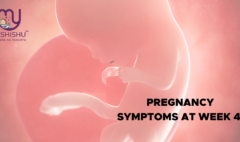Teething issues in child
Teething issues in child
Experiencing your baby’s first tooth and witnessing those delightful toothy grins are moments every parent eagerly awaits and cherishes. However, the teething stage comes with its own set of trials. In this blog, “Teething issues in child” with MyShishu provides insights into the teething journey in children, covering topics such as the onset of teething, observable signs and symptoms, and crucial care during this crucial developmental phase.
When Does Teething Commence?
Teething, the process of your child’s first teeth emerging, typically initiates between six and 12 months of age. Although some babies may undergo teething earlier or later, it’s essential to pay attention to signs like tender gums, increased drooling, and gnawing behavior, indicating an imminent tooth eruption.

Your Child’s Teething Timeline: Teething issues in child
Understanding your child’s unique teething timeline is paramount. On average, infants will witness the emergence of four teeth every six months, comprising the initial set of primary or milk teeth. These will eventually make way for adult teeth between the ages of six and 12 years. The first tooth generally appears between four and seven months, while a complete set of 20 primary teeth is expected by the age of three.
How Long Does Teething Last?
Teething is a gradual process spanning a couple of years, with the final set of primary teeth making an appearance between your child’s second and third birthdays. Symptoms tend to ebb and flow, with discomfort preceding the eruption of a new tooth and subsiding once the tooth has surfaced.
You’re my favorite reason to lose sleep.
Teething Symptoms: Teething issues in child
Teething symptoms vary from child to child, with some experiencing minimal discomfort. Common signs include:
- Irritability: Increased fussiness and crying.
- Disturbed Sleep: Nighttime awakenings due to teething pain.
- Excessive Drooling: A natural response to soothe tender gums.
- Gnawing on Objects: Babies may chew on toys or fingers to alleviate gum pressure.
- Sore, Swollen Gums: Redness and tenderness where the tooth is emerging.
- Low-Grade Temperature: A slightly elevated temperature, typically below 100.4°F.
Your Child’s Teething Schedule: Teething issues in child
Teething unfolds through various stages, and here’s a general idea based on age:

- 4-7 months: First tooth, usually one of the front lower teeth (central incisors).
- 8-12 months: Top front teeth (central incisors).
- 9-16 months: Lateral incisors on either side of the front teeth.
- 13-19 months: First molars on the top.
- 16-23 months: Sharp canines.
- 23-33 months: Second molars, completing the set of 20 primary teeth.
Adjusting to Different Teething Times: Teething issues in child
Teething is unique to each child, and there’s no need for concern if your child’s teething timeline differs from others. Allow your child’s teeth to emerge naturally when they’re ready.
Soothing Teething Discomfort: Teething issues in child
Managing teething discomfort requires a personalized approach. Consider these methods:
- Teething Rings: Provide a clean, chilled teething ring for your child to chew on.
- Gum Massage: Gently massage your child’s sore gums with a clean finger.
- Comfortable Bedtime Routine: Establish a calming bedtime routine to aid relaxation.
- Consult Your Pediatrician: If discomfort persists, consult your pediatrician for guidance on pain relief.
A toddler can do more in one unsupervised moment than most people can do all day.
Caring for Your Child’s New Teeth: Teething issues in child
As teeth emerge, dental care becomes essential. Start by:
- Regular Brushing: Begin brushing your child’s teeth as soon as they appear. Use a smear of fluoride toothpaste on a soft-bristled brush.
- Dietary Considerations: Avoid sugary drinks and snacks to promote dental health.
- Dental Check-ups: Schedule your child’s first dentist visit around the time of the first tooth or by their first birthday.
FAQs about Teething: Teething issues in child
- How do you know if your baby is teething? Signs include crankiness, disrupted sleep, drooling, chewing on objects, and tender gums.
- How do you soothe a teething baby? Use teething rings and gently massage gums with a clean finger.
- Can a three-month-old be teething? Teething can start as early as three months, but it varies.
- How early do infants start teething? Teething typically begins between six and 12 months.
- Can eight-week-old babies start teething? While rare, some babies may start teething as early as eight weeks.
- What do babies’ gums look like when teething? Gums may appear red, tender, and swollen where the tooth is emerging.
- When do you start brushing baby teeth? Begin brushing as soon as the first tooth appears.
Conclusion: Teething is an integral part of your child’s growth, marked by the emergence of those precious baby teeth. While challenges may arise, armed with knowledge and care, you can navigate this phase with confidence. MyShishu is here to support parents every step of the way, ensuring that each toothy grin is a symbol of a healthy and happy child. Embrace the journey, celebrate the milestones, and keep that adorable smile shining bright!
Celebrate each step of your child’s journey and remember that parenting is an ever-evolving adventure. Stay tuned for more insightful blogs from MyShishu!
Explore our range of courses on new-age parenting at New-Age Parenting | Modern Parenting Styles | MYSHISHU.
For additional parenting insights and valuable information, check out our blog “Cry, Feeding and Weaning of Newborn Baby” at Cry, Feeding and Weaning of Newborn Baby – My Shishu.
Hope you’ve enjoyed the blog “Teething issues in child”. Happy Parenting!











